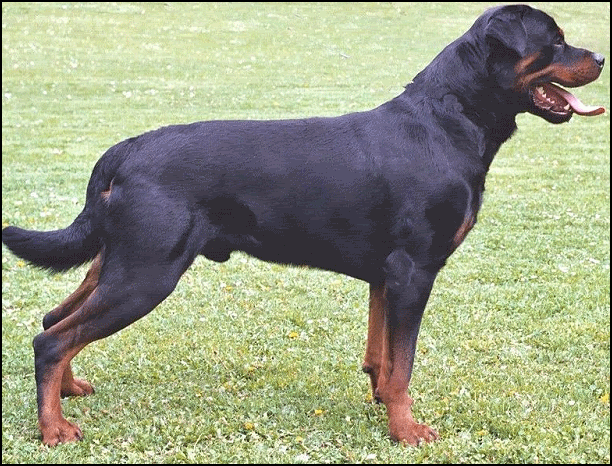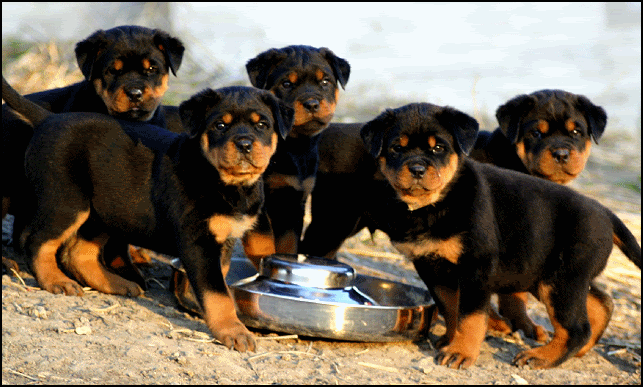Post by Sit Kitty on May 19, 2008 20:11:43 GMT -5
Rottweiler
Group: 3 - Working Dogs
Origin: Germany
Purpose: Cattle Drover, Gaurdian, and Draft Dog

Description:
Large, very recognizable breed originally bred as a herding dog and was often used as a beast of burden. During the first and second World Wars, Rottweilers were put into service as war time guard dogs. Currently they are frequently used as guard and police dogs.
Appearance:
Black medium-length coat (dense, straight, and coarse) with tan markings on face, chest, and legs. Low maintenance coat consists of a waterproof undercoat and a coarse top coat. The head is broad, round and of medium length. Ears are triangular, pendant, and medium sized, and prick up to change the overall profile of the head when the dog is in an alert state. The expression is proud, alert and self-assured. The body is compact and muscular, with a level back – the dog is generally slightly longer than it is tall. The tail is generally docked short. The Rottweiler’s gait can be described as a trot, projecting confidence, power and balance.

Size:
According to FCI standard, the Rottweiler stands 61 to 68 cm (24-27 inches) at the withers for males, and 56 to 62.5 cm (22-25 inches) for bitches.[1] Average weight is 50 kg (130 pounds) for males and 42 kg (95 pounds) for bitches.
Temperament:
In general they are fond of children, very devoted, quick to learn, and eager to please. However, if they are not receiving the mental stimulation they need (as with most dogs), they will find creative and sometimes destructive ways to elicit it. Such behavioral problems as chewing and barking for attention can be a result of lack of human interaction. A steady dog with a self-assured nature, the Rottweiler has a natural tendency to assert dominance if not properly trained. Not usually a barker, male Rottweilers are silent watchers that notice everything before they attack; barking is usually a sign of annoyance with external factors (car alarms or other disturbances) rather than a response to actual threats.
Health:
The Rottweiler is a tough and hardy breed, but potential owners should be aware of known health issues that can affect this breed. Rottweilers are highly prone to be affected by serious diseases mainly to its hips. The most serious genetic health risks a Rottweiler faces are canine hip dysplasia (CHD), subvalvular aortic stenosis (SAS), elbow dysplasia, and osteosarcoma. Other conditions which may affect this breed include hypothyroidism, gastric torsion (bloat), torn crucial ligament and allergies. The Rottweiler has a preference for cooler climates and may become overheated if not given adequate water and shelter on hot days.
Average Lifespan:
Rottweilers typically live between 8 and 11 years.
History:
The breed is an ancient one, whose history stretches back to the Roman Empire. In those times, the legions traveled with their meat on the hoof and required the assistance of working dogs to herd the cattle. One route the army traveled was through Württemberg and on to the small market town of Rottweil. The principal ancestors of the first Rottweilers during this time was supposed to be the Roman war dog. This region eventually became an important cattle area, and the descendants of the Roman cattle dogs proved their worth in both driving and protecting the cattle from robbers and wild animals. However, by the end of the 19th Century, the breed had declined so much that in 1900 there was only one female to be found in the town of Rottweil. The build up to World War I saw a great demand for police dogs, and that led to a revival of interest in the Rottweiler. From that time the breed has become popular with dog owners, and in 1935 was officially recognized by the American Kennel Club.

Source:
en.wikipedia.org/wiki/Rottweiler
www.breederretriever.com/dog-breeds/77/rottweiler.php
Group: 3 - Working Dogs
Origin: Germany
Purpose: Cattle Drover, Gaurdian, and Draft Dog

Description:
Large, very recognizable breed originally bred as a herding dog and was often used as a beast of burden. During the first and second World Wars, Rottweilers were put into service as war time guard dogs. Currently they are frequently used as guard and police dogs.
Appearance:
Black medium-length coat (dense, straight, and coarse) with tan markings on face, chest, and legs. Low maintenance coat consists of a waterproof undercoat and a coarse top coat. The head is broad, round and of medium length. Ears are triangular, pendant, and medium sized, and prick up to change the overall profile of the head when the dog is in an alert state. The expression is proud, alert and self-assured. The body is compact and muscular, with a level back – the dog is generally slightly longer than it is tall. The tail is generally docked short. The Rottweiler’s gait can be described as a trot, projecting confidence, power and balance.

Size:
According to FCI standard, the Rottweiler stands 61 to 68 cm (24-27 inches) at the withers for males, and 56 to 62.5 cm (22-25 inches) for bitches.[1] Average weight is 50 kg (130 pounds) for males and 42 kg (95 pounds) for bitches.
Temperament:
In general they are fond of children, very devoted, quick to learn, and eager to please. However, if they are not receiving the mental stimulation they need (as with most dogs), they will find creative and sometimes destructive ways to elicit it. Such behavioral problems as chewing and barking for attention can be a result of lack of human interaction. A steady dog with a self-assured nature, the Rottweiler has a natural tendency to assert dominance if not properly trained. Not usually a barker, male Rottweilers are silent watchers that notice everything before they attack; barking is usually a sign of annoyance with external factors (car alarms or other disturbances) rather than a response to actual threats.
Health:
The Rottweiler is a tough and hardy breed, but potential owners should be aware of known health issues that can affect this breed. Rottweilers are highly prone to be affected by serious diseases mainly to its hips. The most serious genetic health risks a Rottweiler faces are canine hip dysplasia (CHD), subvalvular aortic stenosis (SAS), elbow dysplasia, and osteosarcoma. Other conditions which may affect this breed include hypothyroidism, gastric torsion (bloat), torn crucial ligament and allergies. The Rottweiler has a preference for cooler climates and may become overheated if not given adequate water and shelter on hot days.
Average Lifespan:
Rottweilers typically live between 8 and 11 years.
History:
The breed is an ancient one, whose history stretches back to the Roman Empire. In those times, the legions traveled with their meat on the hoof and required the assistance of working dogs to herd the cattle. One route the army traveled was through Württemberg and on to the small market town of Rottweil. The principal ancestors of the first Rottweilers during this time was supposed to be the Roman war dog. This region eventually became an important cattle area, and the descendants of the Roman cattle dogs proved their worth in both driving and protecting the cattle from robbers and wild animals. However, by the end of the 19th Century, the breed had declined so much that in 1900 there was only one female to be found in the town of Rottweil. The build up to World War I saw a great demand for police dogs, and that led to a revival of interest in the Rottweiler. From that time the breed has become popular with dog owners, and in 1935 was officially recognized by the American Kennel Club.

Source:
en.wikipedia.org/wiki/Rottweiler
www.breederretriever.com/dog-breeds/77/rottweiler.php

